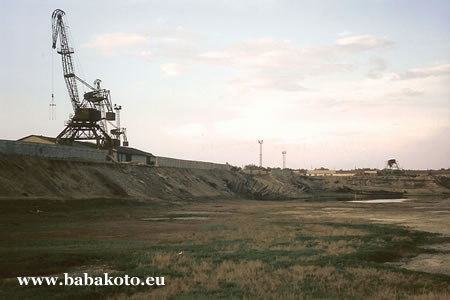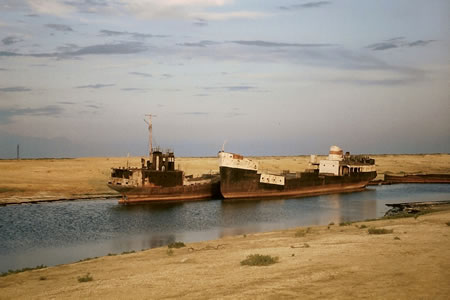English | Dutch |
|
| Aralsk – an ecological disaster | |
Aralsk (Kazakhstan), July 3rd 1996 |
|
Often you can read stories about ecological disasters caused by mankind, most of the time as result of maximizing economic growth. One of the disasters has happened in the former Soviet Union. In present Kazakhstan the Aral Lake is located, once the fourth largest lake of the world. A visit in 1996 to the city of Aralsk (once located on the shore of the Aral Sea) made a deep impression on me.
This ecological disaster started in the first half of the previous century. The communistic party in Moscow centrally governed the Soviet Union. From their offices, the leaders decided that Central Asia would become the cotton shed of the Soviet Union. This was planned to be one of the major economical motors to finance the plans of the Soviet Union. However, Central Asia is an area where the ground is infertile and the climate is dry. Not the perfect place to grow cotton. A solution was found by designing a complex irrigation system in where the Syr Darya and Amu Darya (two big rivers) were the providers of the water. The designers of this plan did not see, or didn’t want to see, that there were designing a major ecological disaster. The use of huge amounts of water from these two rivers caused the drying up of the Aral Sea. In the first years, the disaster was not visible yet. The water level of the Aral Sea did not decline. The reason was that the irrigation was still limited to the fertile parts of Central Asia that were close to the river. The water was used efficiently. But it was not enough for the leaders of the Soviet Union. The cotton fields were extended to more infertile areas. This caused an exponential growth in water use. Besides that, the fields were located further from the rivers. The water was transported in open (above the ground) concrete gutters, which caused a lot of evaporation. Besides that, the gutters were of bad quality, which led to lot op leakages. In the beginning of the 80’s, the water supply of the two rivers to the Aral Sea was decreased to only 10% of the 50’s. |
|
 |
|
Harbour crane at dry harbour |
|
| The drying up of the Aral Sea was not the only consequence of the irrigation project. Last decennia, a real ecological disaster has happened. The animal life in and around the Aral Sea is almost dead. The major reason is the low level of water supply to the Aral Sea, and the high salt level in the water. The declining water level in combination with the high salt amounts, have resulted in large salt areas. This is not an area for a rich animal life.
Also the fishing industry disappeared. The main former fishing towns along the Aral Sea were Aralsk in present Kazakhstan and Muynak in present Uzbekistan. Both town are now more than 40 kilometers away fro the lakeshore! In the beginning, the towns tried to keep access to the declining lake by digging channels from their harbors to the lake. But at the end, they lost the access to the lake, resulting in the end of the fishing industry and the migration of many people to other parts of the country. The result is two ghost towns in the middle of the desert. If you take a stroll through Aralsk, you will see the disaster of the irrigation policy of the former Soviet Union. It is unreal to see a complete harbor, including harbor cranes and railways, in the middle of the desert. You can take a walk over the bottom of the harbor and look up to the giant harbor cranes, or take a close look at one of the many ships that ‘died’ in the harbor. Also the canal, to keep access to the lake in the past, is still visible. On different places in the cannel you see old and rusty ships that stranded somewhere in the last century as victim of the drying up of the lake. You have to see, to believe it. The town of Aralsk changed in less than 50 years from a prosperous fishing town to an unhealthy desert ghost town. | |
 |
|
Rusty victims of the former Soviet Union's irrigation policy |
|
| The story can be worse. The area is changed in a very unhealthy place to live. The people who still live here are not capable anymore to build up a healthy live. The irrigation in the past with salty water resulted in very infertile ground on where agriculture is almost impossible. Besides that, the ground is poisoned by the huge amount of poison (like pesticides) used in the past to maximize the crops. The low level of water supply in combination with the huge amounts of poison in the past, results in extreme high concentrations in existing rivers and lakes.
Finally, also the climatological conditions are changed. As result of the drying up of the Aral Sea, the summers in this area are hotter and dryer. This makes it even more difficult to do agriculture in this area. The change in wetter also resulted in more sand storms that contain besides sand also salt from the salt plains. The high concentration of sand and salt in the air has a bad impact on the health of the people. Scientists state that this is the reason why this area has a high cancer and birth mortality rate (more than 10%). But what about the future? Already in the Soviet era, scientists were thinking about a possible solution for this disaster. But with the falling apart of the Soviet Union, the process of finding a solution is delayed. The reason is that more countries are now necessary in finding the solution. In the past, the Soviet Union was the only party, but now Kazakhstan, Uzbekistan, Turkmenistan, Kyrgyzstan and Tadzjikistan are involved. The last two countries do not have the negative influence of the disaster, but are crucial for the process because they are the countries in where the Syr Darya and Amu Darya springs. Because of the own interests involved for each of these countries, the process of finding the best solution will be very difficult. The future will learn. | |